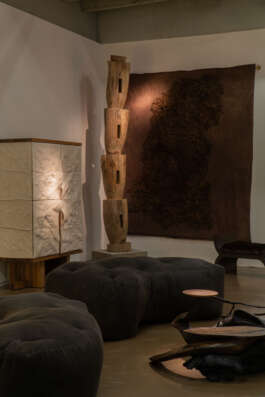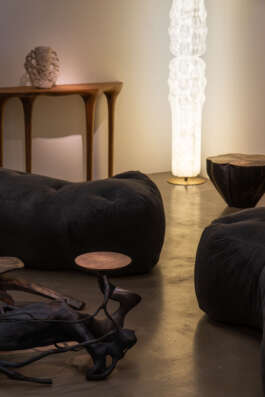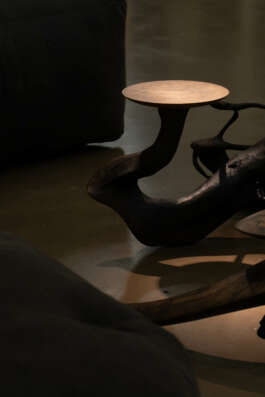



© La Lune
COLLECTIBLE In-Depth
March 2025
This series, COLLECTIBLE In-Depth, unveils the backstage of contemporary creation. Tackling various topics from personal designer processes to the position of collectible design on the global design market, COLLECTIBLE In-Depth offers different views to suit all tastes. Today we talk to Madeleine Froment, co-founder of La Lune.
COLLECTIBLE: How did you enter the world of collectible design? Why did you create your gallery?
Madeleine Froment: La Lune was born from a deep desire: to reconcile art, craftsmanship, and respect for the living world. At the core of this vision, we held a strong conviction: the objects we choose and the spaces we inhabit go beyond their function. They carry emotions and meaning. More than just a gallery, La Lune celebrates artisanal authenticity. Each piece tells a unique story—one of ancestral gestures, carefully selected materials, and an ethical intention guiding every creation.
In the face of today’s ecological and societal crises, our ways of living and consuming are evolving. In this context, design and craftsmanship must reinvent themselves to merge aesthetics and ethics. Founded in 2018 by Madeleine Froment and Mehdi Adraa, La Lune positions itself as a driver of change, responding to the growing demand for authenticity, sustainability, and a deep connection with nature. By supporting committed creators and responsible practices, we affirm the essential role of craftsmanship as a vehicle for transformation and innovation.
C: What are the key questions you ask yourself before conceptualizing an exhibition?
M: Now more than ever, we believe that the challenge lies in conveying values and telling stories based on the narratives of the people we work with. Globally, we are facing many uncertainties, stress, and a loss of meaning. We have personally found great comfort in supporting our artists, understanding their creative process, and exploring why they chose to turn to craftsmanship.
We strive to bring our ideas and values to life through the exhibitions we curate. We seek a guiding theme that inspires us as we begin our work and direct our artists toward it, allowing the pieces to engage in dialogue. This theme may come from poetry, literature, or artistic and historical references. This exhibition expresses a strong connection across different eras of humanity—some objects directly reference ancient or primitive styles. We were particularly influenced by a documentary on the Chauvet Cave and its 30,000-year-old drawings.
C: Can you tell us about the designers you are presenting at COLLECTIBLE this year? What makes their practice or pieces unique?
M: We collaborate with our artists in various ways: we enjoy observing their creative evolution and capturing moments of their reflection, but we also guide them and commission specific pieces based on our needs or current inspirations.
For this exhibition, we asked Claire Cosnefroy to create a cabinet version of a sideboard we previously showcased during Paris Design Week. In attesa is a ceramic and walnut piece born from the collaboration between her work and that of designer Paul Michelon, under our artistic direction. Claire Cosnefroy is a ceramist who has developed a distinct graphic language with clay while maintaining a strong sculptural approach.
Paul Michelon also contributed to the creation of the Roman shelf, an ode to ornamentation that brings figurative sculpture back into functional furniture design. Victor Giannotta designed and crafted these sculptures, drawing inspiration from Brut, Roman, and Egyptian art. These two pieces embody the meeting of expressive sculptural creation and meticulous design and construction, thanks to Paul’s approach.
This is a new direction that excites us, and we look forward to expanding these collections and bringing together new talents.
C: How do sustainability concerns influence your practice?
M: Our entire approach revolves around the question of sustainability—it is at the heart of our original inquiry: Why produce today, and how?
The answer unfolds naturally by working on a small scale and locally, collaborating with artists rooted in their territories. Sustainable solutions emerge as common sense, without major obstacles.
By redefining production scales and reconsidering an object’s lifespan, we discover effective solutions. Centering human fulfillment in creation and questioning the reasons behind making things brings the world back into balance.

© La Lune

Madeleine Froment, Dena, 2022 © Nomades Studio
COLLECTIBLE In-Depth
March 2025

© La Lune
This series, COLLECTIBLE In-Depth, unveils the backstage of contemporary creation. Tackling various topics from personal designer processes to the position of collectible design on the global design market, COLLECTIBLE In-Depth offers different views to suit all tastes. Today we talk to Madeleine Froment, co-founder of La Lune.
COLLECTIBLE: How did you enter the world of collectible design? Why did you create your gallery?
Madeleine Froment: La Lune was born from a deep desire: to reconcile art, craftsmanship, and respect for the living world. At the core of this vision, we held a strong conviction: the objects we choose and the spaces we inhabit go beyond their function. They carry emotions and meaning. More than just a gallery, La Lune celebrates artisanal authenticity. Each piece tells a unique story—one of ancestral gestures, carefully selected materials, and an ethical intention guiding every creation.
In the face of today’s ecological and societal crises, our ways of living and consuming are evolving. In this context, design and craftsmanship must reinvent themselves to merge aesthetics and ethics. Founded in 2018 by Madeleine Froment and Mehdi Adraa, La Lune positions itself as a driver of change, responding to the growing demand for authenticity, sustainability, and a deep connection with nature. By supporting committed creators and responsible practices, we affirm the essential role of craftsmanship as a vehicle for transformation and innovation.
C: What are the key questions you ask yourself before conceptualizing an exhibition?
M: Now more than ever, we believe that the challenge lies in conveying values and telling stories based on the narratives of the people we work with. Globally, we are facing many uncertainties, stress, and a loss of meaning. We have personally found great comfort in supporting our artists, understanding their creative process, and exploring why they chose to turn to craftsmanship.
We strive to bring our ideas and values to life through the exhibitions we curate. We seek a guiding theme that inspires us as we begin our work and direct our artists toward it, allowing the pieces to engage in dialogue. This theme may come from poetry, literature, or artistic and historical references. This exhibition expresses a strong connection across different eras of humanity—some objects directly reference ancient or primitive styles. We were particularly influenced by a documentary on the Chauvet Cave and its 30,000-year-old drawings.
C: Can you tell us about the designers you are presenting at COLLECTIBLE this year? What makes their practice or pieces unique?
M: We collaborate with our artists in various ways: we enjoy observing their creative evolution and capturing moments of their reflection, but we also guide them and commission specific pieces based on our needs or current inspirations.
For this exhibition, we asked Claire Cosnefroy to create a cabinet version of a sideboard we previously showcased during Paris Design Week. In attesa is a ceramic and walnut piece born from the collaboration between her work and that of designer Paul Michelon, under our artistic direction. Claire Cosnefroy is a ceramist who has developed a distinct graphic language with clay while maintaining a strong sculptural approach.
Paul Michelon also contributed to the creation of the Roman shelf, an ode to ornamentation that brings figurative sculpture back into functional furniture design. Victor Giannotta designed and crafted these sculptures, drawing inspiration from Brut, Roman, and Egyptian art. These two pieces embody the meeting of expressive sculptural creation and meticulous design and construction, thanks to Paul’s approach.
This is a new direction that excites us, and we look forward to expanding these collections and bringing together new talents.
C: How do sustainability concerns influence your practice?
M: Our entire approach revolves around the question of sustainability—it is at the heart of our original inquiry: Why produce today, and how?
The answer unfolds naturally by working on a small scale and locally, collaborating with artists rooted in their territories. Sustainable solutions emerge as common sense, without major obstacles.
By redefining production scales and reconsidering an object’s lifespan, we discover effective solutions. Centering human fulfillment in creation and questioning the reasons behind making things brings the world back into balance.

© La Lune

Madeleine Froment, Dena, 2022 © Nomades Studio
Contact
info@collectible.design
VIP PORTAL
EXHIBITOR PORTAL
PRIVACY POLICY
© 2025 Collectible
Contact
info@collectible.design
VIP PORTAL
EXHIBITOR PORTAL
PRIVACY POLICY
© 2025 Collectible